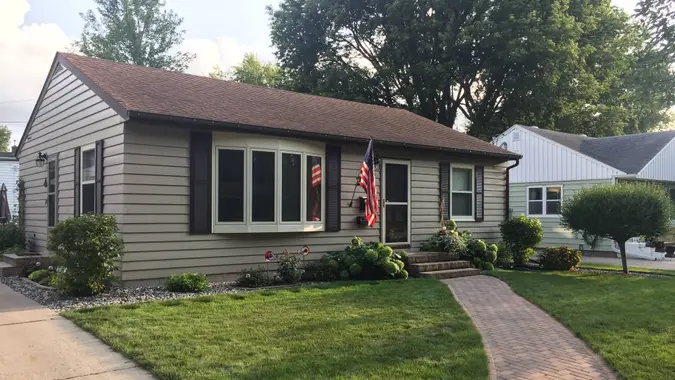What Income Do I Need for a $300K House?

Commitment to Our Readers
GOBankingRates' editorial team is committed to bringing you unbiased reviews and information. We use data-driven methodologies to evaluate financial products and services - our reviews and ratings are not influenced by advertisers. You can read more about our editorial guidelines and our products and services review methodology.

20 Years
Helping You Live Richer

Reviewed
by Experts

Trusted by
Millions of Readers
Income is one of the main factors lenders consider on your mortgage application. Not only do they need to make sure you can afford the principal and interest, but they also want to know you’ll be able to keep up with property tax and homeowners insurance as well as the maintenance required to protect the home’s value.
See: 3 Things You Must Do When Your Savings Reach $50,000
With median home prices reaching $431,000 in October, according to the Federal Reserve Bank of St. Louis, buyers are having to walk a fine line when it comes to affordability. But what, exactly, does affordability mean in terms of income? GOBankingRates breaks it down for you using a $300,000 home as an example.
How Much Do I Need To Make To Buy a $300K House?
There’s no specific dollar amount of income required for a $300,000 home because lenders evaluate your income in the context of other factors, such as the type of loan, your down payment amount, other debt and the strength of your credit. However, lenders do have guidelines you can apply to your personal financial situation to determine how much income you need. The guidelines relate to your debt-to-income ratio, which compares your debt payments to your gross monthly income, and they might let you buy a $300,000 house with an income of roughly $93,336 per year.
How Much Is the Monthly Payment on a $300K House?
Say you wanted to purchase a $300,000 home. Ideally, you’d make a 20% ($60,000) down payment and finance the remaining $240,000. A 30-year fixed-rate loan at a 7.5% interest rate would have a monthly principal and interest payment of about $1,678.
However, lenders also include property tax, homeowners insurance and, if the home is in a planned community, homeowners association fees when they calculate house payments. That’s because your home serves as collateral for the mortgage loan, and getting behind on these items puts the collateral at risk. If you were to stop paying property tax, for example, the city or county could sell your home in a tax sale. If you were to let your homeowners insurance lapse, there’s no guarantee you’d be able to pay the cost of repairing or rebuilding out of pocket. Counting these costs as part of your house payment is the lender’s way of ensuring that you can afford to both purchase the home and maintain it.
So add to that $1,678 principal and interest payment $200 per month, which is the average monthly payment for homeowners insurance. Then add another $300 per month for property tax — that’s roughly one month’s worth of the median property tax amount in the U.S. Assume for this example that there is no HOA fee. The total house payment, then, is $2,178.
How To Calculate DTI
DTI is expressed as a percentage. Say you have $5,000 per month in income, and your debt payments — loans, credit cards, lease payments and alimony and/or child support, for example — equal $1,000 per month. Divide $1,000 by $5,000 to get the ratio. In this example, it’s 0.20, or 20%. Your DTI, then, is 20%.
Front-End DTI vs. Back-End DTI
Lenders consider two types of DTI:
- Front end, which is your housing payment, including mortgage principal and interest, property taxes, homeowners insurance and, if applicable, homeowners association dues
- Back end, which includes front-end debt plus the minimum monthly payments on all of your other debt obligations, including leases, included in your credit report
Lenders like to see a front-end DTI of no more than 28%. For a $300,000 home with a house payment of $2,178, you’d need about $7,778 per month, or $93,336 per year, in income to stay within 28%.
Back-end DTI is more important to lenders because it gives them a more complete and accurate picture of your finances. Maximum back-end DTIs vary by loan type.
For a conventional loan, lenders want to see a back-end DTI of 36% to 50%, depending on your down payment, credit score and cash reserves other than funds you’ll use for your down payment and closing costs.
A back-end DTI of 36% or less gives you the best chance of having your loan application approved. With an income of $93,336, you could have total debt payments of $2,800 per month — $2,178 for your house payment and $622 for all other debt payments combined.
At 50% DTI, for which you would need an excellent credit score, large cash reserves and a large down payment, you could have a total debt payment of $3,889 — $2,178 for your house payment and $1,711 for your other debt payments combined.
A more realistic goal is to not exceed 43% to 45% DTI. A 43% DTI would allow you $3,345 in total debt, $1,167 of which could go to debt other than your house payment.
Maximum DTIs for Government-Backed Loans
Loans backed by the Federal Housing Administration, Veterans Affairs and the U.S. Department of Agriculture have maximum DTIs that are set by the agency that insures or guarantees the loans. While lenders can set stricter requirements, it’s possible to be approved with the following DTIs:
- FHA loans: 45%, or up to 47% for well-qualified borrowers
- VA loans: No VA-imposed limit, but above 41% requires special eligibility criteria
- USDA loans: Front-end limit of 29%, or up to 32% for well-qualified borrowers; back-end limit of 41%, or up to 44% for well-qualified borrowers
How To Qualify for a $300K House If Your Income Is Too Low
If your income falls short, improving your DTI could help you qualify for a $300,000 home.
Pay Down Your Debt
If your house payment would be within 28% of your gross income but other debt pushes you above back-end DTI limits, paying down the debt will reduce your minimum monthly payments and bring down your DTI. It could also raise your credit score, which could help you qualify for a lower rate and/or a higher DTI, either of which can help you qualify for a larger loan.
Make a Larger Down Payment
You can purchase a home with 5% down with a conventional loan — 3.5% for FHA, and 0% for VA and USDA — but that leaves you having to borrow more. A larger down payment reduces the amount of financing you need so you qualify for more house with less income. For the biggest impact, pay at least 20% down to avoid having to pay mortgage insurance. That will reduce your payment and your DTI even more.
Buy Mortgage Points
Mortgage points are interest payments you pay in advance, at closing. They reduce the interest rate on your loan, which also reduces your payments. Lower payments could reduce your DTI enough to qualify you for a $300,000 loan.
How Much House Can I Afford?
If you’re at the beginning stages of planning to buy a home, a good way to start is by getting a general idea of how much house you can afford. A rule of thumb recommended by Fidelity says that three to five times your income is a reasonable goal, but if you have a lower income, you might have to compromise to keep your payments affordable.
Can I Afford a $300K House on a $60K Salary?
A home that expensive would stretch your budget. You would need a down payment of more than 50% to keep your front-end DTI at 28% or less. At today’s rates, a more realistic goal is to limit your purchase to three to four times your income rather than try to stretch it to five.
How Much House Can I Afford If I Make $36K a Year?
With an income of $36,000 per year, $108,000 to $144,000, or three to four times your income, is a realistic goal at today’s rates, but that might be a stretch. A safer goal would be to buy a home costing two to three times your salary, or $72,000 to $108,000. A USDA loan would let you have a payment of up to $960 per month, but you’d need a down payment for a home at the higher end of that range.
Final Thoughts
If you find that your income just isn’t enough to qualify you for a home purchase, your best bet might be to stop the search for now and work on strengthening your finances. You can do that by getting a new, higher-paying job in your current field, which could qualify you for more financing immediately. Alternatively, consider taking a second job for the next couple of years — you’ll need a two-year history for lenders to consider it. That way, you have time to increase not just your income, but your savings as well.
Our in-house research team and on-site financial experts work together to create content that’s accurate, impartial, and up to date. We fact-check every single statistic, quote and fact using trusted primary resources to make sure the information we provide is correct. You can learn more about GOBankingRates’ processes and standards in our editorial policy.
- Consumer Financial Protection Bureau. 2023. "What is a debt-to-income ratio?"
- Rocket Mortgage. 2023. "Debt-To-Income Ratio (DTI): What Is It And How Is It Calculated?"
- Freddie Mac. 2022. "The Math Behind Putting Down Less Than 20%."
- Chase. "The 20% myth: How much down payment do you need for a house?"
 Written by
Written by  Edited by
Edited by 




























